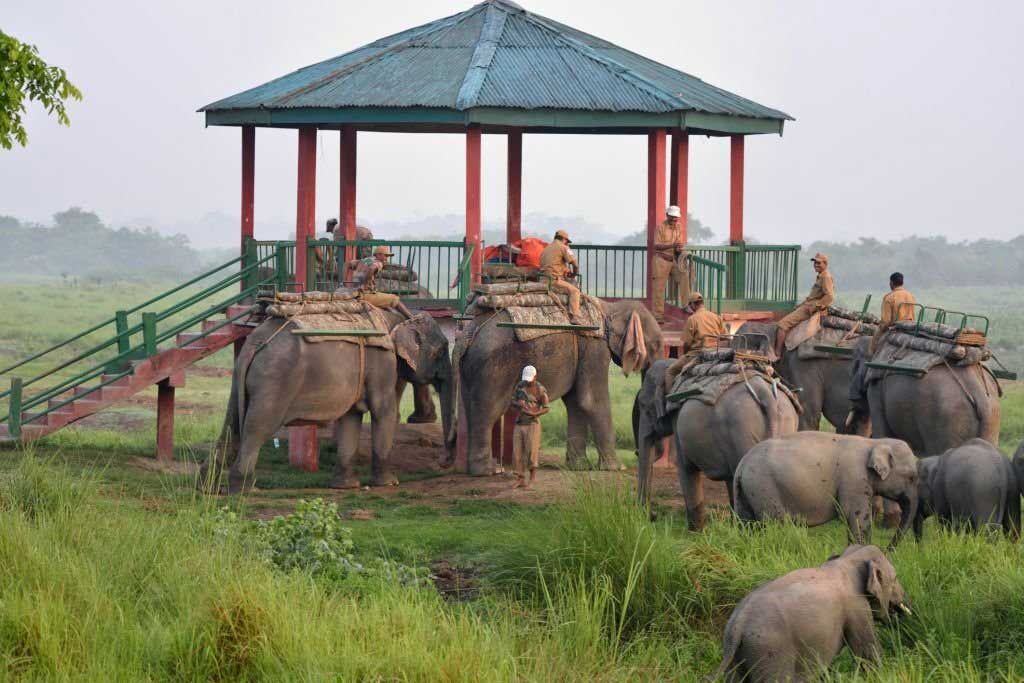
The Kaziranga National Park is a UNESCO world heritage site. The authorities concerned declared the vast bio-diverse area as a ‘National Park’ in 1974.
Nomenclature:
The nomenclature of ‘Kaziranga’ has been adopted from the name of a Karbi ruler. According to Karbi mythology, she ruled in this area during the ancient times.
Location:
This famous Park lies between latitude 26 degree 30N to 26 degree 45N and longitude 93 degree 08 E to 93 degree36 E. The Kaziranga National Park stretches across two districts in the north-eastern Indian State of Assam. A section of this protected area is in Bokakhat Sub-division of Golaghat District whereas the other part falls in Kaliabor subdivision of Nagaon District.
Boundaries:
Towards the northern side of this forest reserve flows the Brahmaputra River while the undulating hills of Karbi Anglong District form its southern boundary
Weather:
During winter, the Kaziranga National Park experiences maximum temperature of 26 degree Celsius and minimum temperature of 10 degree Celsius. On the other hand, during summer, the maximum temperature rises to 37 degree Celsius while the minimum temperature drops to 22 degree Celsius.
Speciality:
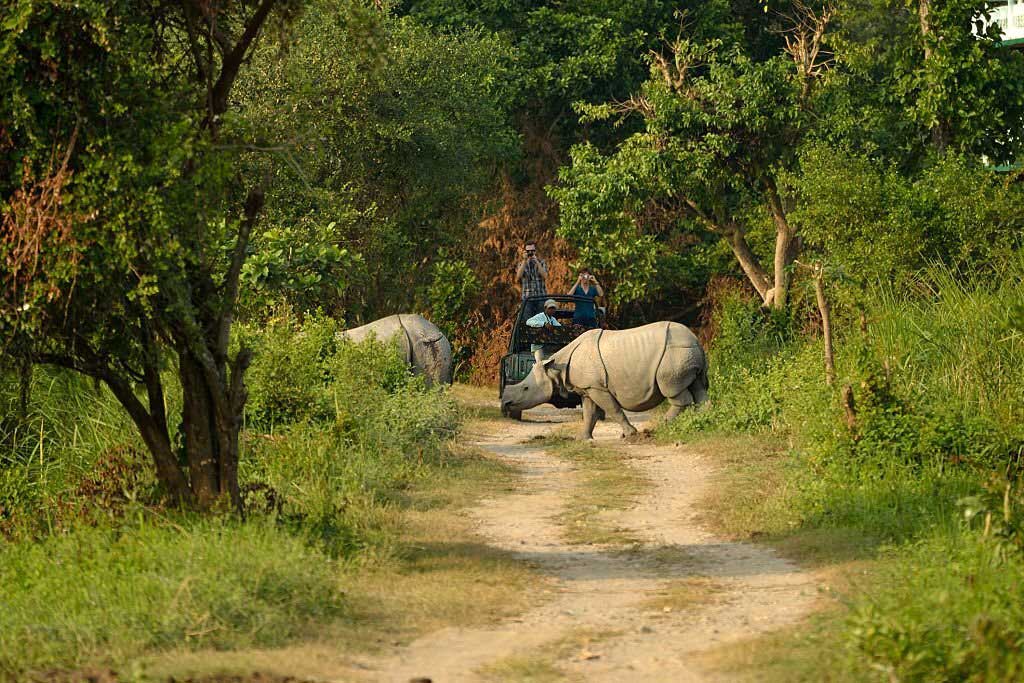
The national park is known as the natural habitat of the Great Indian one-horned rhinoceros. In fact, the world’s largest population of one-horned rhinoceroses resides within the park. This protected park is spread across approximately 430 sq km is home to two-third of the global rhino population.
Varied Species Of Animals:
Besides, the natural park has varied species of other animals including mammals like bears, elephants, panthers and tigers. Moreover, environmentalists and foresters have recorded the presence of large numbers of wild Asiatic water buffaloes, and elephants. Moreover, the park is home to the Indian Muntjac, and also the hog and swamp deer. Sambars and gaurs are two other species of animals that inhabit the park. A Tiger Reserve has been also identified inside the ‘Protected Area’. The Brahmaputra River flowing beside the park further attracts the highly endangered Ganges Dolphin.
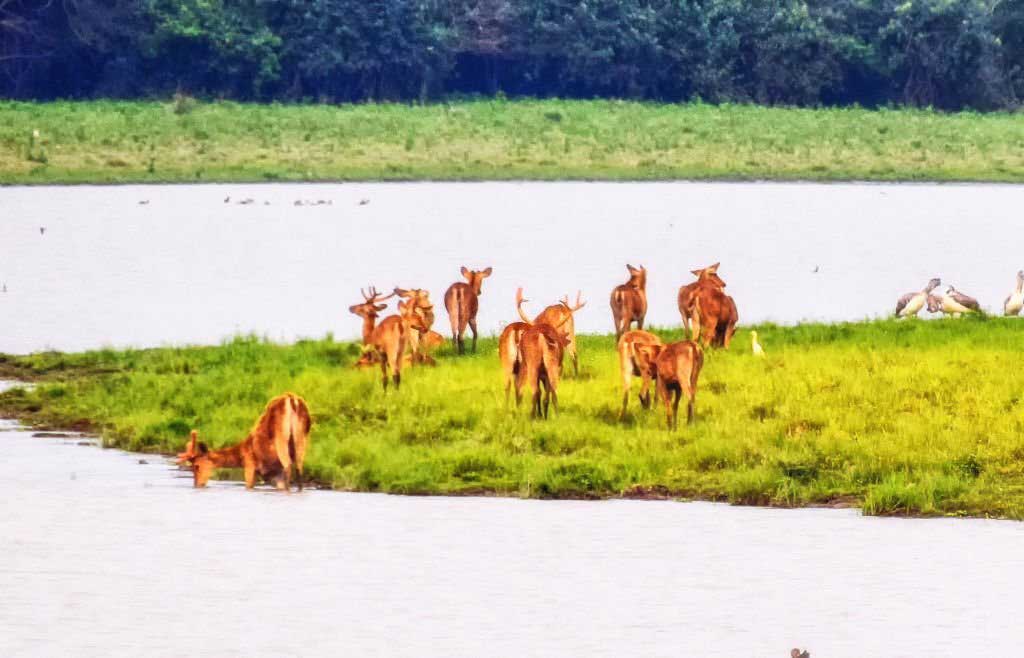
Kaziranga: An Avian Paradise
The ‘Protected Area’ of Kaziranga National Park is an ‘Avian (birds) paradise’. Avians of many species dwell here. The ‘Birdlife International for conservation of avifaunal species’ has already demarcated a wide stretch of this park as an ‘Important Bird Area’. The park has more than 300 species of avian species.
Picturesque Landscape:
The sanctuary is blessed with Besides the picturesque landscape the park is endowed with varied wildlife species. It is also a treasure trove of flora and fauna. Hemmed by the lovely table-top tea bushes of a number of tea estates, the National Highway-37 unequally parts a significant part of the idyllic landscape of the park. Often, rhinos, deer, and wild elephants stray into the highway. The lovely landscape of Kaziranga comprises shallow pools and marshes, as well as rugged reeds, tall elephant grass, and also forest areas.
Tourist Destination:
The Kaziranga National Park attracts tourists both from within the country and abroad. The park remains open for visitors for six months, from November to April. The bird-watching points within. Kaziranga National Park attracts tourists.
Safaris:
The prime attractions for tourists include the safaris — on elephants and in open-source jeeps. During the safaris, the tourists are taken around selected areas of the park.
Boat Cruises:
One can further opt for boat cruises on the Brahmaputra along the park. Besides being exhilarating, the cruises offer a quick glance on the evergreen environ of the park.
THE ‘Kohora Chowk’:
The ‘Kohora Chowk’ is an important bird-watching point. Tourists invariably visit this spot.
Tracing The Tracks:
Up to the early part of 19th Century, the forested region presently identified as the ‘Kaziranga National Park’ was naturally open to the vagaries of nature.
Monsoon, Erosion & Poaching In Kaziranga
Large portions of the forest are eroded by the annual floods especially during the monsoon season when the State experiences torrential rainfall. The monsoon rain lashes the region from the later part of March onwards. The rain continues sporadically till August. To flee from the rising water of the Brahmaputra and it’s tributaries, the hapless animals migrate to the safer highlands in Karbi Anglong. At times, deer and other small animals die while crossing the highway due to rash driving by unscrupulous drivers. This is despite the Forest department’s signboards and vigil to check such drivers. Nowadays, the Government has has undertaken various measures to arrest such erosion and also reclaim such eroded portions.
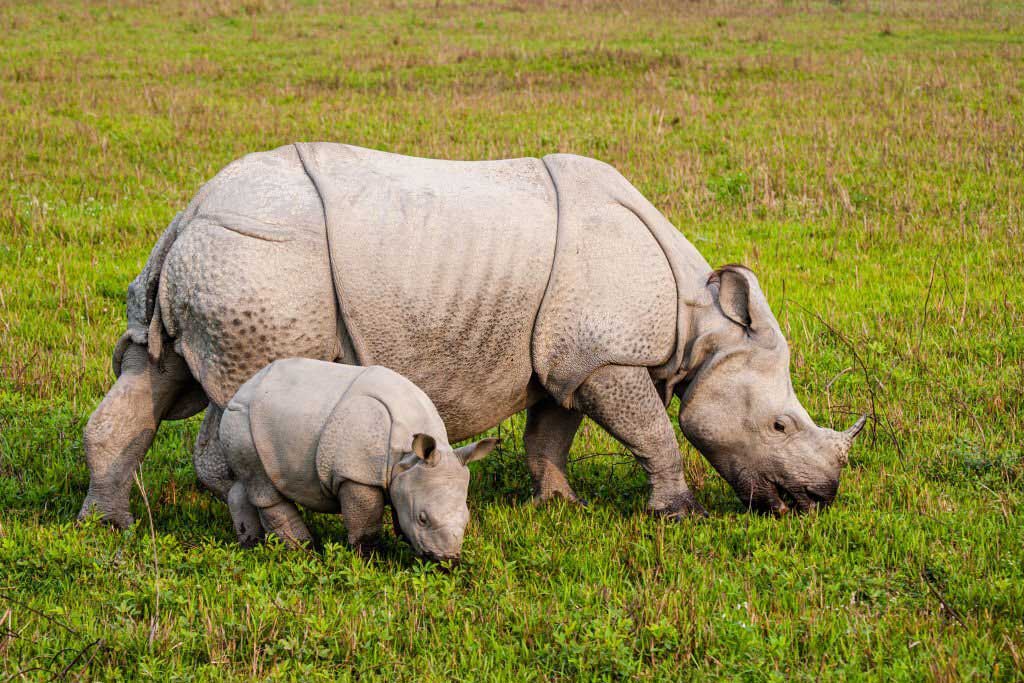
Poaching:
Poachers were quite active in the region till the early part of the 2000. The poachers primarily target the endangered one-horned rhinoceros (for the horn), and the elephants (for the tusk). Bear and other mammals like tigers, reptiles, and even rare birds used to fall prey to the sinister designs of poachers.
Countering Poachers:
To counter the poachers, the Government of Assam has involved the local people as sentinels of the park. This strategy has worked tremendously. Moreover, the authorities concerned have modernised the Forest guards, who maintain strict vigil round the clock. The guards are equipped with thee latest forms of weapons
Forest Ranges:
The Kazaringa National Park has two important forest ranges. These are the Bagori and Burapahar Ranges. Both the ranges of this ‘Protected Area’ are located within the district of Nagaon.
Online Safari Bookings For Kaziranga
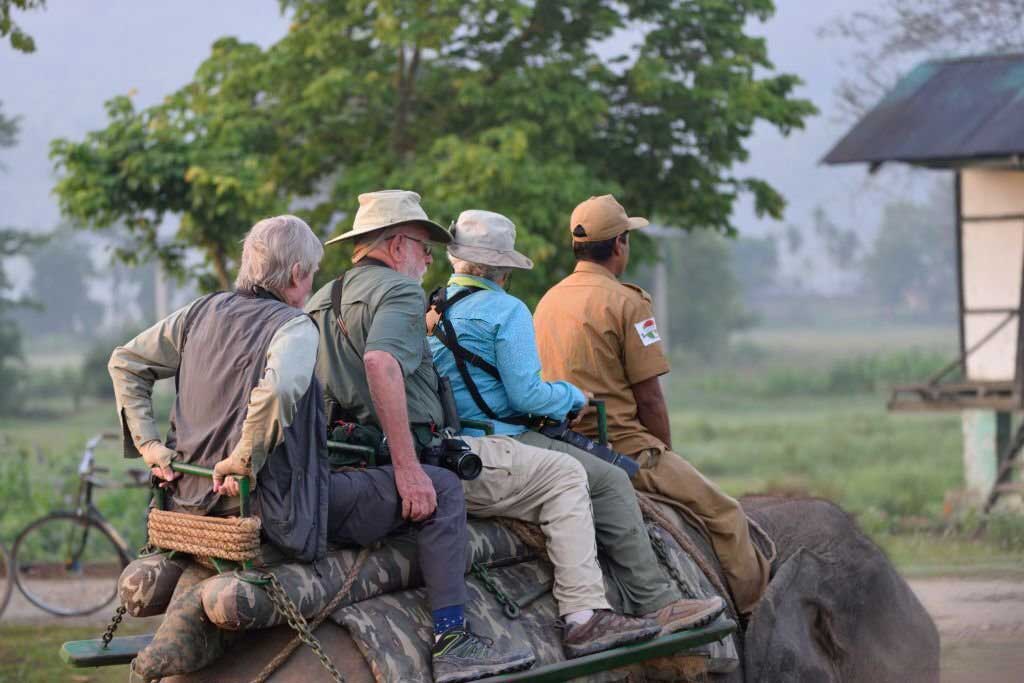
The Kaziranga National Park offers both jeep and elephant safaris to the tourists for exploring and sighting of the varied wild life. Both the (jeep and elephant) safaris allow the tourists not only to enjoy the picturesque environ of the park but also witness the animals and birds in their natural habitat. The Kaziranga Forest department administers and manages the process by strictly following the set guidelines.
Online Booking For Safaris:
One can easily opt for online booking for safaris (both jeep and elephant) in the Kaziranga National Park. Similarly, the tourists should check the official website of the park and book accommodation in lodges. Of course, there are private accommodation facilities quite near the park. Mentionably, one can go for online jeep-safari booking in all the four tourism zones in the Kaziranga National Park.
Tourism Zones:
The four tourism zones are Kohora, Bagori, Burapahar, and Agartoli. However, the Kaziranga National Park authority allows elephant-safari booking only for the two zones of Bagori and Kohora. All the four zones in Kaziranga National Park have beautiful landscape. Moreover, each of them is endowed with varieties species of flora and fauna.
Advance Booking:
While planning your trip to the park, remember to book your online safari seat(s) well in advance. In this way, the tourists can counter last-minute rush for such bookings.
The Charges:
You will have to pay the full amount. The safari-booking charges include the entry-permit fee, the safari- vehicle fare, and also the guide fee.
Safari Routes:
The safaris proceed via safe picturesque routes that are already charted out within the national park.
Allowed Passengers:
In a single ride, a jeep (offered by the forest department of Kaziranga National Park) used for safari can accommodate the maximum number of six people. It includes the driver and the guide as well. However, only four persons are allowed in an elephant safari.
Safari Timings:
The timings of safari routes in Kaziranga have been carefully decided upon so that the tourists can spot the wild animals (grazing or frolicking or resting) in their natural surroundings.
Kaziranga: Videography, Photography & Entry Rules
One can go for videography only with prior permission of the Kaziranga National Park authority. However, tourists can click photographs of the sylvan surroundings.
Prime Attractions:
The prime attractions of Kaziranga National Park are the highly endangered one-horned Indian rhinoceros, Indian elephant, tigers, swamp deer and the water buffalo.
Besides, each of the four zones of the Park also preserves various other wild lives. Tourists enjoy spotting the wild animals as well as the mesmerizing beauty of Mother Nature while proceeding in the jeep and elephant safaris. One of the best wildlife destinations in India, the trip to the Kaziranga National Park remains etched in the memory of tourists.
Permit Probabilities:
The entry permit for the jeep safari is depends upon the availability of the vehicles. On the other hand, the permit for elephant-safari ride is based on the basis of per seat.
Safari-Booking Procedure:
The Park authority issues permits for the safaris on a first-come-first service basis but subject to availability. Tourists will have to follow a procedure while making online safari booking in the Kaziranga National Park. They must share the following details with the Park authority: The full name, age, and gender as well as the other details enumerated on their respective identity cards. Besides, they need to mention their preferred trip date and also opt for either of the fixed safari timings (Morning/Afternoon). They will also have to state the specific ID card tourist number as mentioned in any of these documents, namely Aaadhar No., Voter ID, Driving License among others.
Mandatory Rules For Foreign Tourists:
For making online safari booking in Kaziranga, the foreign tourists must provide all the details recorded in their passports.
Kaziranga: Basic Facts About Online Safari Booking
- You must know the following basic facts before opting for the online safari booking in the Kaziranga National Park:
- The Park management governs the rules and procedures of online safari booking;
- You will have to pay the entire fees to make advance online safari booking; You cannot cancel or transfer the entry permit for safari ride once it is issued by the Forest department of the National Park; You must keep with you the same ID card which you had submitted while making your online safari booking; The tourist must pay the charged amount in advance for booking the safaris.
- After the Park management confirms the ‘Safari Permit’, one cannot claim refund against the e-permits.
- This is because the e-permits are non -refundable.
- The Park authority allows only those registered vehicles and guides that are allowed for the safari rides.
- The Park management allot the vehicles and guides randomly; and tourists cannot change them.
- Safari permit to the tourists is issued on a first-come-first basis depending upon the availability of the safari.
- The Kaziranga Forest department has full right to decide closure of the park owing to unavoidable reasons. Hence, the Park may be closed at times of exigency without prior notice to the visitors;
- If the Park authority decides to revise the safari fees even after one makes the online safari booking, then you will have to pay the difference amount while entering the park.
- You must report at the safari-boarding spot 15 minutes before the scheduled departure time.
- The Park conducts only two shifts of Safari rides, i.e., in the morning and evening.
- Tourists cannot enter the Park after sunset since it is prohibited by law.
- It is not legitimate to get down from the vehicles during their safari ride.
- The tourists cannot take their pets into the Kaziranga National Park.
- Last but not the least, tourists must co-operate with the officials of Kaziranga Forest department to maintain law and order.
Formalities Prior To Entering The National Park:
Tourists must possess the entry permit before entering the Kaziranga National Park as it is a completely restricted and protected zone under TRA (Tiger Reserve Area). You must possess the official safari permit to enjoy both the kinds of safari ride namely, Jeep safari and Elephant safari. The safaris are conducted strictly following the rules and regulations of the Park Forest department. The duration of each safari ride is fixed. The safari charges include jeep/elephant safari fares, driver/Mahuout fees as well as the entry-permit charges.
How The Park Came Into Being:
There is an interesting story as to how the park came into c. The history of Kaziranga as a protected area traces back to 1904, when Mary Victoria Leiter, the wife of the Viceroy of India, Lord Curzon, visited the area.
It so happened that once while visiting the area she did not see even a single rhinoceros there. Then, Lady Curzon urged her husband to propose a means to protect these exotic pachyderms in their natural habitat.
Mary Victoria Leiter’s Contribution:
Mary Victoria Leiter was the wife of Lord Curzon — the Viceroy of India. She is credited with starting the movement for rhinoceros conservation.
Initially, the Kaziranga National Park was set up as a ‘Proposed Reserve Forest’.
PRE-INDEPENDENCE ERA: It is said that owing to her request, the region came into being as the ‘Kaziranga Proposed Reserve Forest’ in June 1905.
During those times, the park measured approximately 90 square miles (232 square km).
Of course since then, the park continued to expand. During the course of the following three years, the park area expanded to around 150 square miles (380 square km), stretching up to the Brahmaputra River.
Notably it was also during that time that the area was declared as a ‘reserve forest’.
In 1916, the authorities declared the protected region as the ‘Kaziranga Game Sanctuary’. They also allowed hunting within the park until 1938, when it was banned officially.
Post-Independence Era:
During the post-Independence era when in the 1950s the country became a ‘Democratic Republic’ (after the Constitution of India came into force), the government renamed the park area as the ‘Kaziranga Wildlife Sanctuary’.
This move was undertaken as the original name referring to it as a “game reserve” became a misnomer particularly because hunting was disallowed in that area.
In 1954, the Government of Assam passed the Assam (Rhinoceros) Bill. It imposed heavy penalties for poaching of rhinoceros.
Fourteen years later in 1968, the State government passed the ‘Assam National Park Act’, thereby upgrading Kaziranga as a designated national park. However, the announcement was published in the Gazette six years later, i.e, in 1974.
Unesco Heritage Site:
Finally in 1985, the UNESCO (United Nations Education Scientific & Cultural Organisation) included Kaziranga in its list of ‘World Heritage Site’.
Now, the local residents along with the conservationists including the Forest personnel staunchly protect the entire park area.
Measurement:
The park measures around 25 miles (40 km) from its eastern edge to the west, and 8 miles (13 km) from it’s northern side to the south. Overall, the park stretches across an area of 146 square miles (378 sq km).
Topography:
The topography if Kaziranga park is generally flat. There is not much difference in it’s elevation.
The Brahmaputra flows along both the eastern and northern edges whereas the southern edge has the Mora Diphlu River.
As the park is surrounded by rivers, there are quite a number of sandbars. The rich silty soil is heavy in nature.
Monsoon Landscape:
Many temporary ponds and lakes form a part of the landscape features especially during the monsoon season when heavy rains lash the State. These wet months usually commence around the middle part of April and continue till around the fag end of August and early part of September.
‘SAPORIES’: During these six months, the wild animals seek refuge in what is known in Assamese as the “sapories”. Such riverine islands are the naturally formed raised areas inside the park. They offer safety for animals during this flooding season.
Vegetation:
Leaving aside the sandbars and lowlands, the entire Brahmaputra Valley abounds in subtropical, tropical forests marked by moist broadleaf forests and also savanna shrub lands and grasslands.
These are besides the semi-evergreen forests that are found in the areas of higher elevation.
THE ‘BigGoFpq OF KAZIRANGA:
The park is internationally prominent for the ‘Big Five’ — the Rhinoceros (2,613 nos), Tiger (116 nos), Elephant (1,165 nos), Asiatic Wild Buffalo and the Eastern Swamp Deer (1,148 nos).
The Great Indian One-Horned Rhinoceros:
The Kaziranga National Park and Tiger Reserve is globally known especially as a natural habitat of the Great Indian one-horned rhinoceros.
In fact, the largest population of this pachyderm — the largest of the rhino species — is concentrated within this park.
‘RED DATA BOOK’: This rhino species is included in the list of highly endangered animals of rhe ‘Red Data Book’ of IUCN.
Sentinels:
Strong involvement in the conservation efforts and vigil of local communities have gone a long way in checking rhino poaching, which was a major issue prior to 2016.
Incidentally, during the annual monsoon-time, rhinos and many other wild animals die in the floods that inundate the park.
All in all, concerted moves of the government, sincere efforts of the Forest personnel added to the dedication of local residents have safeguarded the park. Such joint actions have also played a pivotal role in maintaining the growing population of rhinoceros within the protected area of rhis park.
14th Rhino Census Operation:
To smoothly carry out the three-day 14th census of the one-horned rhinos, the authorities closed the Kaziranga National Park for tourists from March 26 (Saturday) to March 28 (Monday), 2022.
Though morning elephant safari rides were suspended from March 26 to 28, jeep safaris rides continued in a phased manner so as not to hamper the rhino census.
The census was conducted in 48 compartments within the the national park premises.
A total of 63 specialists carried out the census in the park.
The other members who took part in the rhino-counting operation included a team of officials of the State Forest department, and volunteers.
Since Kaziranga is in news due to the incessant killing of rhinos in recent years, census is important to know the actual figure of rhinos in the park.
To conduct the 2022 rhino census, the entire park was divided into 74 compartments. Of them, the census was completed in 36 compartments on the first day while the rest was done the next day.
Talking Heads:
Making public the findings of Census-2022 on March 29 (Tuesday), a forest official in Kaziranga said, “This is a delightful moment for all of us as the number has gone up by 200. We believe that the news about rise in population of the rhinos will attract more tourists to Kaziranga,” added the Forest official.
The Director of Kaziranga National Park, Jatindra Sarma said in a statement that a total of 64 enumerators including 12 independent observers and 49 media observers were part of the exercise in 26 compartments selected randomly for the sample survey.
“As many as 50 elephants and 252 frontline staff were engaged to cover the 84 compartments spread over Kaziranga National Park, its additions and civil areas.
“GPS binoculars were also given to the enumerators while drones were used for the first time for sample recheck,” stated Sarma in the statement.
The last rhino census in 2018 found an increase of a dozen individuals over the 2015 figure.
“A total of 150 people including support staff members were engaged in the exercise which is being carried out in all the additions of the park,” said Divisional Forest Officer of Kaziranga National Park, Rohini Ballav Saikia.
Saikia also informed that they focused on extensive use of GPS to find out which tracks are frequently used by rhinos for their movement.
2022 Rhino Census Data:
The number of one-horned rhinos at Kaziranga National Park in Assam has increased by 200 in the last four years.
The 2022 census shows that there are a total of 2,613 rhinos within the protected area.
The 2018 rhino census registered 2,413 pachyderms in the national wildlife park.
According to the 2022 census that concluded on March 29, altogether 903 female adult rhinos were found. The census further recorded 146 calves in the park.
The 14th Rhino Census-2022 was carried out between March 25 and 28 across the 900-odd sq km wildlife park.
The census indicated 1,670 adults (above six years), 365 sub-adults (3 to 6 years), 279 juveniles (1 to 3 years) and 146 calves (0 to 1 year).
The adult rhinos included 750 males, 903 females, and 17 “un-sexed,” which means their gender could not be ascertained during the census.
A Success Story:
Internationally, this estimate is a major improvement in comparison to the previous decades when the rhinoceros in general was hunted and also poached to such an extent that experts and environmentalists estimated only 200 existed in the earlier part of the 20th Century.
Following stringent protection rules and conservation efforts on a mission mode by Nepal and also India, approximately 3,700 rhinos existed in the wilderness as of 2021.
This effort has been deemed the greatest success of any conservation effort across Asia. Conservation has been a major success story in Kaziranga, and this is particularly so with respect to all the wildlife species including the Royal Bengal tiger and also the Great One-horned Indian Rhinoceros.
Bengal Tiger:
The Bengal tiger is a subspecies of the Continental Tiger.
It is a big cat that generally found in the Asian mainland. Tigers, and particularly the species of Bengal tiger, is listed as endangered, and their populations have been generally decreasing over the past decades.
According to the WWF (World Wildlife Foundation) records in 2021, there were an estimated 3,500 continental tigers in the wilderness.
However, poaching as well as loss of habitat led to a drastic slide of this wildcat species.
Nevertheless, conservation areas including those in Kaziranga have played a significant role in the upkeep of this species.
Incidentally, the Government of Assam declared the Kaziranga National Park as a ‘Tiger Reservation area’ in 2006.
During this time, the region registered the highest concentration of Bengal tigers anywhere in the world.
Official estimates pegged it at 1 per 5 sq km, and a population of 118.
Swamp Deer & Asiatic Water Buffaloes:
Further, the Kaziranga National Park has the largest populations of the eastern swamp deer — besides other deer species — as well as the Asiatic water buffalo in the world.
Elephants:
Moreover, herds of wild Indian elephants also are frequent visitors to the park.
Of course, you can book safaris on domesticated pachyderms sponsored by the Kaziranga park authorities.
Other Animals:
Among other animals and herbivores found in the protected area are the sloth bear, varieties of boar, and also jungle cats including leopard cat, fishing cats, leopards, the golden jackal, Bengal fox, and of course, the Bengal tiger.
Researchers and environmentalists have also tracked various other animal species in Kaziranga. These include the civets and various species of mongoose — both are varieties of the highly poached Indian and Chinese pangolin.
Primates:
Foresters have further identified nine types of primates in the park.
These include the Assamese macaque, golden langur and the capped langur.
Other Rare Species:
Among the other rare species found in Kaziranga National Park & Tiger Reserve are the endangered hispid hare, and the Ganges dolphin. This dolphin lives in freshwater river. It is found in South Asia. This species is also listed as endangered.
There are also a wide diversity of avian species besides amphibians, reptiles, and invertebrates within the protected area.
The writer — Nilutpal Gogoi is an entrepreneur, senior journalist, writer, translator (from Assamese to English & vice versa), avid traveller, British English Accent & grammar trainer, educationist, and martial arts (Taekwondo) practitioner.

